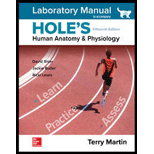
Laboratory Manual for Hole's Human Anatomy & Physiology Cat Version
15th Edition
ISBN: 9781260165401
Author: SHIER, David
Publisher: MCGRAW-HILL HIGHER EDUCATION
expand_more
expand_more
format_list_bulleted
Concept explainers
Textbook Question
Chapter 7, Problem 9CA
Place the zones of cartilage in an epiphyseal plate in order (1—4), with the first zone attached to the epiphysis. (p. 205) __________ zone of hypertrophic cartilage zone of calcified cartilage zone of resting cartilage _________ zone of perforating cartilage
Expert Solution & Answer
Want to see the full answer?
Check out a sample textbook solution
Students have asked these similar questions
Explain in a small summary how:
What genetic information can be obtained from a Punnet square? What genetic information cannot be determined from a Punnet square?
Why might a Punnet Square be beneficial to understanding genetics/inheritance?
In a small summary write down:
Not part of a graded assignment, from a past midterm
Chapter 7 Solutions
Laboratory Manual for Hole's Human Anatomy & Physiology Cat Version
Ch. 7 - Prob. 1PCh. 7 - List five major parts of a long bone.Ch. 7 - Describe the microscopic structure of compact...Ch. 7 - How do compact and spongy bono differ in...Ch. 7 - Describe the development of an intramembranous...Ch. 7 - Prob. 6PCh. 7 - Describe the four layers in an epiphyseal plate.Ch. 7 - Explain how nutritional factors affect bone...Ch. 7 - Prob. 9PCh. 7 - How does physical exercise affect bone structure?
Ch. 7 - Prob. 11PCh. 7 - Distinguish between the functions of red marrow...Ch. 7 - 13 Explain regulation of the concentration of...Ch. 7 - Prob. 14PCh. 7 - Prob. 15PCh. 7 - Prob. 16PCh. 7 - Prob. 17PCh. 7 - Prob. 18PCh. 7 - Prob. 19PCh. 7 - Prob. 20PCh. 7 - 21 Explain the difference between the vertebral...Ch. 7 - Describe a typical vertebra.Ch. 7 - Prob. 23PCh. 7 - Prob. 24PCh. 7 - Prob. 25PCh. 7 - Prob. 26PCh. 7 - Prob. 27PCh. 7 - Prob. 28PCh. 7 - Prob. 29PCh. 7 - Prob. 30PCh. 7 - Prob. 31PCh. 7 - Locate and name each bone that forms the pelvis.Ch. 7 - Prob. 33PCh. 7 - Prob. 34PCh. 7 - Prob. 35PCh. 7 - Prob. 36PCh. 7 - Prob. 37PCh. 7 - Describe how the foot is adapted to support the...Ch. 7 - Prob. 39PCh. 7 - Prob. 40PCh. 7 - Prob. 1CACh. 7 - Prob. 2CACh. 7 - Prob. 3CACh. 7 - Prob. 4CACh. 7 - Prob. 5CACh. 7 - Prob. 6CACh. 7 - Prob. 7CACh. 7 - Prob. 8CACh. 7 - Place the zones of cartilage in an epiphyseal...Ch. 7 - Prob. 10CACh. 7 - Prob. 11CACh. 7 - Prob. 12CACh. 7 - Prob. 13CACh. 7 - Prob. 14CACh. 7 - Prob. 15CACh. 7 - Prob. 16CACh. 7 - Prob. 17CACh. 7 - List three metallic elements that may be...Ch. 7 - Prob. 19CACh. 7 - Prob. 20CACh. 7 - Prob. 21CACh. 7 - Prob. 22CACh. 7 - Prob. 23CACh. 7 - Prob. 24CACh. 7 - Prob. 25CACh. 7 - Prob. 26CACh. 7 - Prob. 27CACh. 7 - Prob. 28CACh. 7 - Prob. 29CACh. 7 - Prob. 30CACh. 7 - Prob. 31CACh. 7 - Prob. 1IACh. 7 - Why are incomplete, longitudinal fractures of bone...Ch. 7 - Prob. 3IACh. 7 - Prob. 4IACh. 7 - When a child’s bone is fractured, growth may be...Ch. 7 - Prob. 6IACh. 7 - Prob. 7IA
Knowledge Booster
Learn more about
Need a deep-dive on the concept behind this application? Look no further. Learn more about this topic, biology and related others by exploring similar questions and additional content below.Similar questions
- Noggin mutation: The mouse, one of the phenotypic consequences of Noggin mutationis mispatterning of the spinal cord, in the posterior region of the mouse embryo, suchthat in the hindlimb region the more ventral fates are lost, and the dorsal Pax3 domain isexpanded. (this experiment is not in the lectures).a. Hypothesis for why: What would be your hypothesis for why the ventral fatesare lost and dorsal fates expanded? Include in your answer the words notochord,BMP, SHH and either (or both of) surface ectoderm or lateral plate mesodermarrow_forwardNot part of a graded assignment, from a past midtermarrow_forwardNot part of a graded assignment, from a past midtermarrow_forward
- please helparrow_forwardWhat does the heavy dark line along collecting duct tell us about water reabsorption in this individual at this time? What does the heavy dark line along collecting duct tell us about ADH secretion in this individual at this time?arrow_forwardBiology grade 10 study guidearrow_forward
arrow_back_ios
SEE MORE QUESTIONS
arrow_forward_ios
Recommended textbooks for you
 Principles Of Radiographic Imaging: An Art And A ...Health & NutritionISBN:9781337711067Author:Richard R. Carlton, Arlene M. Adler, Vesna BalacPublisher:Cengage Learning
Principles Of Radiographic Imaging: An Art And A ...Health & NutritionISBN:9781337711067Author:Richard R. Carlton, Arlene M. Adler, Vesna BalacPublisher:Cengage Learning Human Biology (MindTap Course List)BiologyISBN:9781305112100Author:Cecie Starr, Beverly McMillanPublisher:Cengage Learning
Human Biology (MindTap Course List)BiologyISBN:9781305112100Author:Cecie Starr, Beverly McMillanPublisher:Cengage Learning Biology 2eBiologyISBN:9781947172517Author:Matthew Douglas, Jung Choi, Mary Ann ClarkPublisher:OpenStax
Biology 2eBiologyISBN:9781947172517Author:Matthew Douglas, Jung Choi, Mary Ann ClarkPublisher:OpenStax Anatomy & PhysiologyBiologyISBN:9781938168130Author:Kelly A. Young, James A. Wise, Peter DeSaix, Dean H. Kruse, Brandon Poe, Eddie Johnson, Jody E. Johnson, Oksana Korol, J. Gordon Betts, Mark WomblePublisher:OpenStax College
Anatomy & PhysiologyBiologyISBN:9781938168130Author:Kelly A. Young, James A. Wise, Peter DeSaix, Dean H. Kruse, Brandon Poe, Eddie Johnson, Jody E. Johnson, Oksana Korol, J. Gordon Betts, Mark WomblePublisher:OpenStax College

Principles Of Radiographic Imaging: An Art And A ...
Health & Nutrition
ISBN:9781337711067
Author:Richard R. Carlton, Arlene M. Adler, Vesna Balac
Publisher:Cengage Learning

Human Biology (MindTap Course List)
Biology
ISBN:9781305112100
Author:Cecie Starr, Beverly McMillan
Publisher:Cengage Learning

Biology 2e
Biology
ISBN:9781947172517
Author:Matthew Douglas, Jung Choi, Mary Ann Clark
Publisher:OpenStax

Anatomy & Physiology
Biology
ISBN:9781938168130
Author:Kelly A. Young, James A. Wise, Peter DeSaix, Dean H. Kruse, Brandon Poe, Eddie Johnson, Jody E. Johnson, Oksana Korol, J. Gordon Betts, Mark Womble
Publisher:OpenStax College


Types of Human Body Tissue; Author: MooMooMath and Science;https://www.youtube.com/watch?v=O0ZvbPak4ck;License: Standard YouTube License, CC-BY